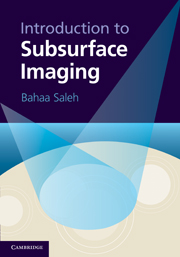Book contents
- Frontmatter
- Contents
- Authors and Contributors
- Preface
- Acknowledgements
- Outline and Roadmap
- 1 Overview
- 2 Physical Models
- 3 Localized Imaging
- 4 Tomographic Imaging
- 5 Digital Image Processing
- 6 Spectral Imaging
- 7 Mosaicing, Change Detection, and Multisensor Imaging
- 8 Numerical Simulation
- 9 Design of Subsurface Imaging Systems
- A Multi-Dimensional Signals and Systems
- B Linear Algebra
- C Detection and Classification
- D Software Tools
- Index
4 - Tomographic Imaging
Published online by Cambridge University Press: 05 June 2012
- Frontmatter
- Contents
- Authors and Contributors
- Preface
- Acknowledgements
- Outline and Roadmap
- 1 Overview
- 2 Physical Models
- 3 Localized Imaging
- 4 Tomographic Imaging
- 5 Digital Image Processing
- 6 Spectral Imaging
- 7 Mosaicing, Change Detection, and Multisensor Imaging
- 8 Numerical Simulation
- 9 Design of Subsurface Imaging Systems
- A Multi-Dimensional Signals and Systems
- B Linear Algebra
- C Detection and Classification
- D Software Tools
- Index
Summary
In localized imaging, each measurement is sensitive to a single point, or a small patch, within the object, so that the object distribution may be constructed by taking measurements at a set of points filling the object space, as illustrated in Fig. 4.0-1(a). As mentioned in Sec. 3.1B, this patch, called the scanned spot, is the intersection of the probe spot and the sensor spot. In tomographic imaging, by contrast, the scanned spot is an extended region of some shape, so that each measurement receives contributions from many points distributed within that spot. Each measurement is then not, by itself, sufficient to discern the individual contributions of the many points within its scanned spot. Nevertheless, by using multiple measurements with overlapping or crossing scanned spots, a set of measurements can be sufficient to figure out the overall object distribution by use of computational methods.
For example, in ray tomography, the scanned spot is a straight line (a ray) and each measurement provides the sum of the values of the object distribution along points of that line. Measurements by use of a set of parallel lines oriented in different directions, as illustrated in Fig. 4.0-1(b), can be sufficient to compute the object distribution. Another example is range tomography. Here, for a two-dimensional (2D) object, the scanned spot is a circle perimeter – the locus of points at the same distance (range) from a fixed point. Each measurement represents the sum of values of the object function at all points on the circle perimeter.
- Type
- Chapter
- Information
- Introduction to Subsurface Imaging , pp. 139 - 188Publisher: Cambridge University PressPrint publication year: 2011

